AI – it’s every marketer’s favourite buzzword of the moment. We’ve had ChatGPT, we’ve had Bard, and it appears everyone now wants a slice of the action. From getting AI to do the ‘dirty’ work – solve problems, write code, streamline tasks, and answer questions – what’s the next step for AI?
Perhaps, we’ll make sole search engines a thing of the past, and answer engines the mark of the future.
We’ve already seen Microsoft Bing’s incorporation of AI and ChatGPT make its way into its search engine results pages. There’s even the option to chat directly with AI-powered search via the ‘Chat’ button, and it can formulate answers generated by AI formulation directly at the top of the page.
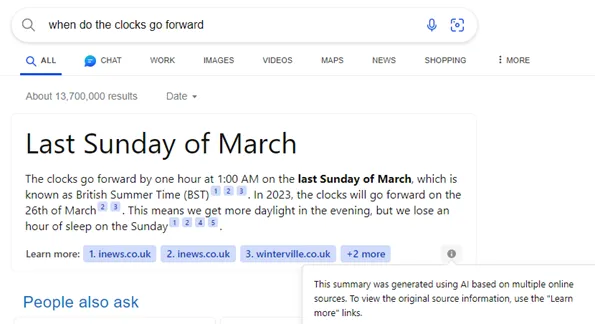
So now, it’s only right that it’s Google’s turn.
Introducing Google’s Generative AI Search Experience
Say hello to Google’s search engine – reimagined – in the below snapshot. If you haven’t seen this yet, you aren’t going mad, it isn’t live. At the time of writing, it’s only available on Labs as an experiment for US-based users (or if you’re sneaky and have a VPN). Presently, you must join a waitlist and wait your turn to try it out – and, you guessed it, we have.
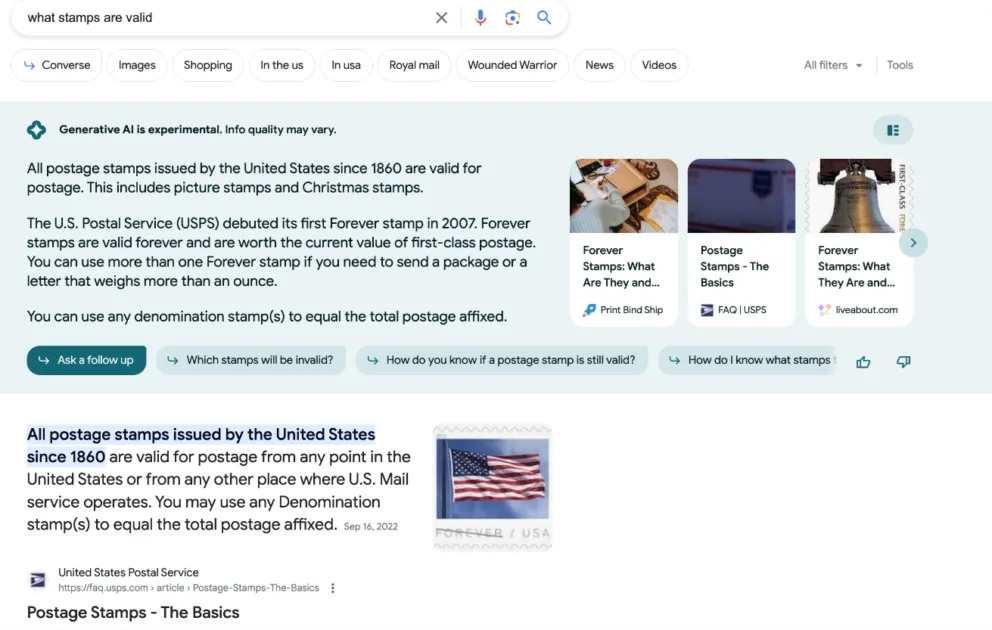
Incorporating a large bit of real estate directly at the top of Google’s search results, the Search Generative Experience is an AI-generated answer box that serves users with information without them needing to click on a website. Google describes the Search Generative Experience capabilities as follows:
“With new generative AI capabilities in Search, we’re now taking more of the work out of searching, so you’ll be able to understand a topic faster, uncover new viewpoints and insights, and get things done more easily.”
Google’s new search experience “places even more emphasis on producing informative responses that are corroborated by reliable sources”.
When it comes to “data voids” or “information gaps” – where Google’s systems have lower confidence in its responses, Google “aims not to generate an AI-powered snapshot,” they stated to Search Engine Land.
How does it work?
This new search experience uses a “variety of LLMs,” (large language model) including but not limited to MUM and PaLM2.
Google’s Multi-Unified Model (MUM)
For a recap – here’s a summary of MUM’s capabilities:
- MUM understands language and generates it.
- MUM is trained across 75 different languages and multiple tasks at once.
- It has a more comprehensive understanding of information and worldly knowledge than previous models, like BERT.
- MUM is multimodal, so it understands information across text and images.
PaLM2 (Pathways Language Model)
For a recap – here’s a summary of PaLM2’s capabilities:
- PaLM2 has a multilingual and diverse pre-training dataset mixture
- The pre-training datasets include hundreds of human and programming languages, mathematical equations, scientific papers, and web pages.
- PaLM2 can filter down a complex task into simpler subtasks.
- It is better at understanding nuances of the human language than previous LLMs.
- PaLM2 excels at understanding riddles and idioms, which is required to understand the ambiguous and figurative meaning of words.
Unlike Bard, Google’s AI chat platform, it is not intended to have a ‘conversation’ with a user, and highlights sources (websites) that it uses to formulate its answers (presently) in a carousel next to the provided result.
When is the experience not triggered? (YMYL!)
Liz Reid, VP of Search at Google, told Search Engine Land that Google’s Search Generative Experience won’t give you answers for everything you ask it.

Google is trying to be careful with this new version and will only show answers for ‘safer’ queries. Google is playing it safe and will not show answers that fall within YMYL (Your Money, Your Life) categories. This also extends to hateful, harmful, and explicit content.
What searches trigger it?
Well, from our own tests, it triggers on most searches performed. In our testing, we made sure to test information-led searches (excluding YMYL queries), Navigational + Commercial (e.g., vases at target), Commercial (e.g. outsourced payroll company) and Transactional (e.g. buy vase).
The one type of search it did not appear to trigger for was Navigational searches alone – e.g., ‘Target’ or ‘Target near me’.
What is happening with featured snippets?
For now, they are still appearing underneath the Generative AI answer box. However – as you can see from the example below – the featured snippet seems somewhat redundant as the AI response is essentially answering the question with more sources and follow-up options.
In our opinion, we can see these being phased out and replaced by the AI answer box in the future. Anyway, why would you rely on an answer from one source when Google can provide you with a more in-depth answer by combining multiple sources?
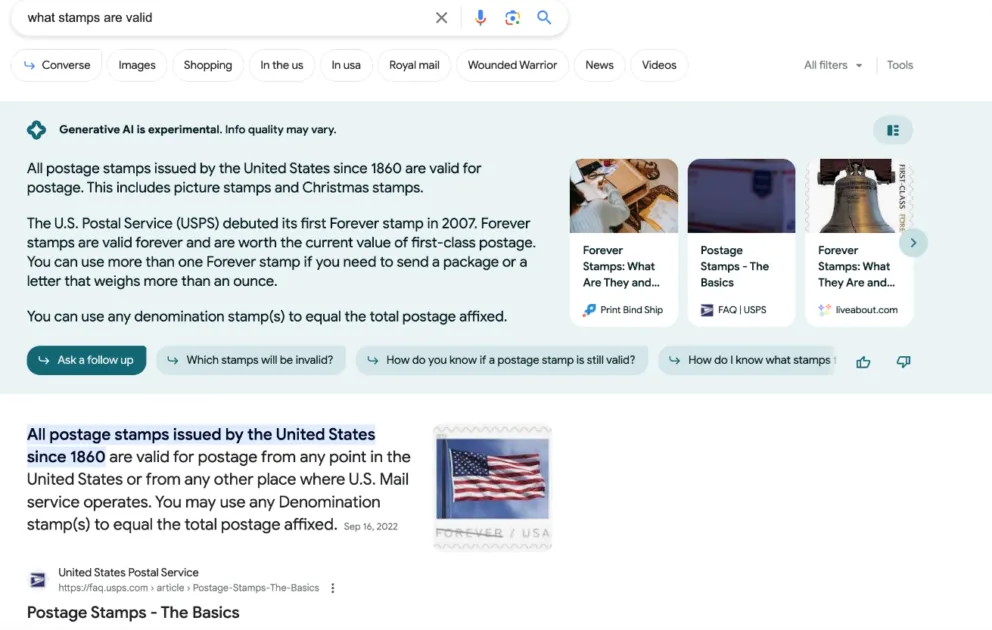
What is happening with ads?
Google will continue to display search ads as part of this new search experience – no concerns there. Ads will be a “native part” of the new Google Search, the VP & GM of Google Ads said, and will appear in dedicated ad positions and slots, carrying the sponsored ad label.
We found some contradictions to articles from Google and third parties during our research. As we tested out Google Search, we only saw text ads and shopping ads underneath the SGE box, whereas there is evidence of them being above the answer box.
As to what ends up staying, we can imagine that Google will want to continue to give them maximum prominence at the top.
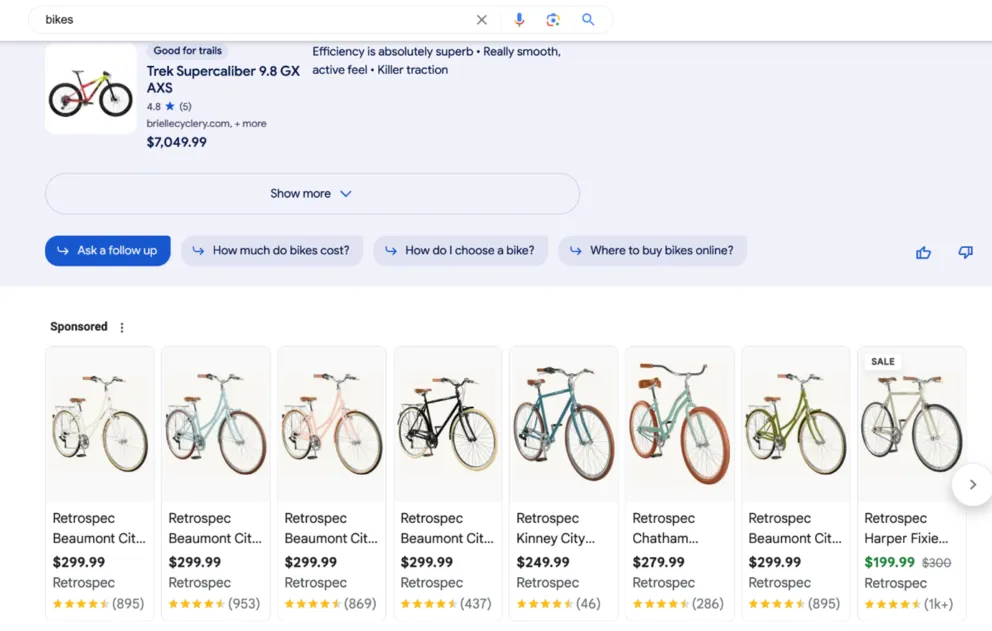
When is it changing over to live search?
The Search Generative Experience as a Labs experiment runs from the end of this year through to December 2023. There is speculation that it will be released for live search prior to this date – though we don’t have any confirmation of what locations and/or languages this could apply to.
What are its implications for SEO and organic search?
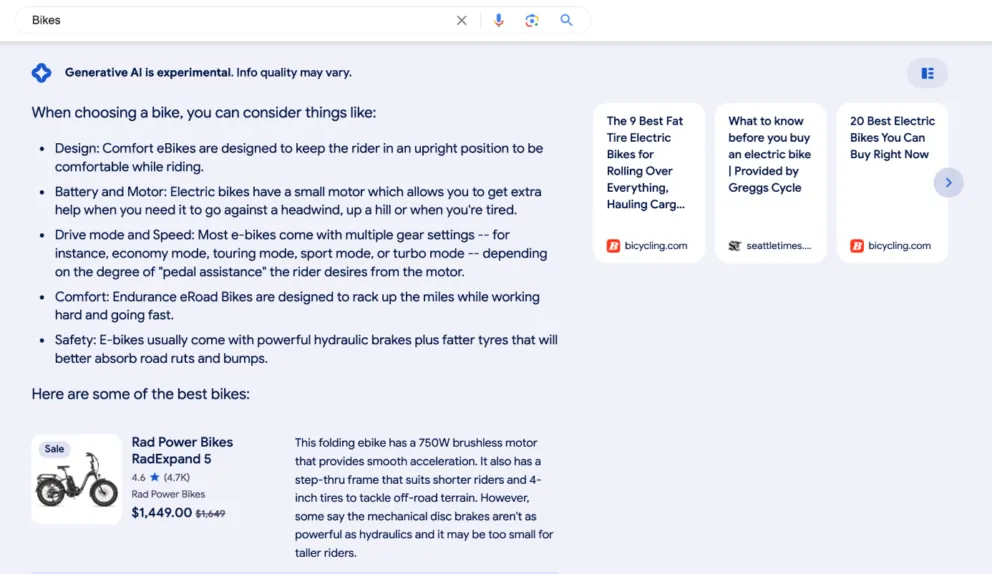
Current sourcing of information could increase zero-click search
In the above example, the carousel of cards, top-right, are sources of the given information. In this default view, a user cannot see what source is attributed to each bit of information – you just get a carousel. If clicked, these take you to your selected site.
In the below example, this is the layout when a user changes to a full-screen view (which is not default, mind you). Sources that were previously summarised top-right are now attributed to each bit of information provided. These sources are clickable and take you to the website.
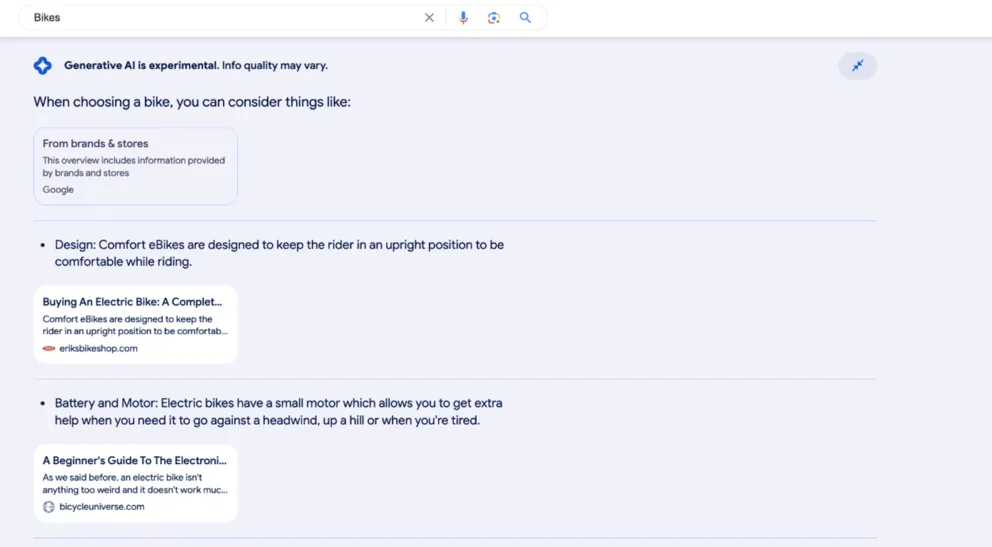
More recently, it’s worth noting that users have spotted Google testing sourcing in line with the default view of the Search Generative Experience answer box (which can only be positive from our perspective). We hope this works beyond just being a test.
How do the ‘sources’ work in the current setup? We tested it ourselves…
The correlation between sources featured in the default carousels and their organic search ranking for a said keyword doesn’t appear to have any clear correlation.
We tested this with the search ‘best places to mountain bike’. Highlighted below, you’ll see there are only two matches between the sources and the ranking websites on page one – and they are in no specific order.
This means that, unlike traditionally featured snippets, it appears you don’t need to be already ranking on page one to have a chance of being utilised as a source for an AI-formulated answer.
‘best things to do on a summers day’
With this second test search, as laid out below, there appears to be no correlation between sources and websites ranking on page one.
One explanation for this could be to do with localised results showing in the organic results (we were ‘based’ in New York for this ‘test’, though this potentially highlights a gap in the AI’s consideration for the request. This shows a potential weakness in limitations to personalisation.
Pushing down organic results could reduce click-through
Naturally, as the size of the answer box is so vast (and expandable), combine this with ads and other SERP features, organic results are going to be pushed down even further, meaning a potential decrease in organic traffic and click-through rate.
Position ‘0’ in the form of featured snippets could disappear
As we referenced earlier, featured snippets could become redundant as they have essentially been superseded by a giant replacement featured snippet. This ‘replacement’ featured snippet also attributes multiple sources, so we will potentially never get that whole position of real estate to ourselves again.
This means previous SEO tactics like featured snippet optimisation will need to be replaced with source/carousel sourcing optimisation. What this entails is yet to be seen.
How can it positively impact SEO?
The whole concept of Google’s Search Generative Experience is that it streamlines the search experience for users, enabling them to understand a topic faster and ultimately uncover new viewpoints and insights.
If anything, this multiple-answer sourcing shows how Google is keen to have multiple experts attached to answering a question, rather than giving prominence to one website’s answer right at the top. The opportunity for visibility is still there, it’s just changed in the way it is presented.
This way of sourcing information means Google is perhaps taking more of a passage ranking approach moving forward, where we don’t necessarily need to write whole pieces of content about a niche subject to rank and we could potentially be broader in our content approach to topics moving forward.
How do we approach future SEO (or AEO – Answer Engine Optimisation)? How will it change?
When big changes like this are on the horizon, this is often when SEO is needed the most.
As fellow SEOs know, we are pros at adapting to change – in algorithms and ranking factors, in techniques, with SEO tools – and though we may be unclear on how it will change in the future, for now, we will be able to adapt.
SEO tools will also need to adapt to this future change in the SERPs and we don’t know what techniques will work for optimisation in this new format as of yet.
We can assume that we will need to:
- Follow best practice SEO with onsite, offsite and technical SEO.
- Avoid thin, regurgitated content online.
- Focus on semantic search – entities and topicality.
- Be more direct and more to the point with information-led pieces – specifically when answering a question (similar to how we approach featured snippet optimisation).
- Some sources recommend that we should focus on conversational, opinionated content with a clear perspective that isn’t easily answered by the generative AI experience.
- We must lead with E-E-A-T! People want opinions from people they trust.
- We can see this with Google’s additional AI feature coming out – ‘Perspectives’.
Be ready for the future of search
With so many changes occurring in the way we search and get our answers online, it’s important that your business stays abreast of these and adapts to the ever-changing search landscape. You can read more about our expert SEO services for yourself to see how we can help.






